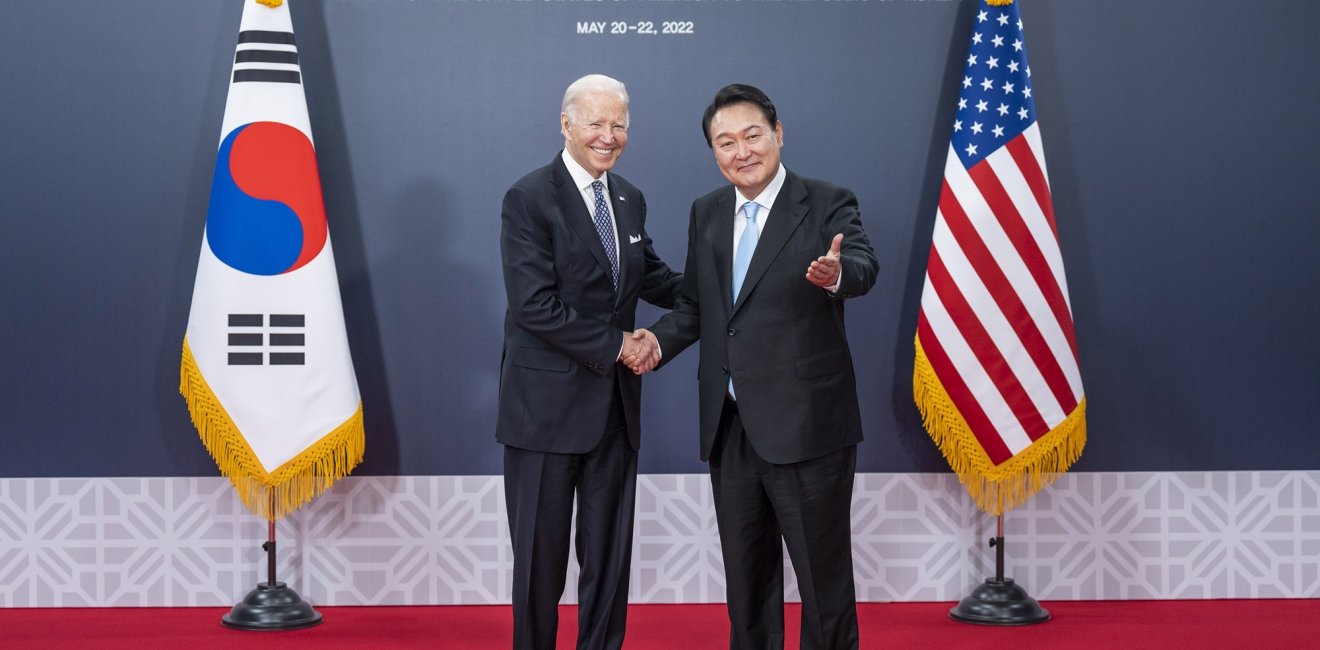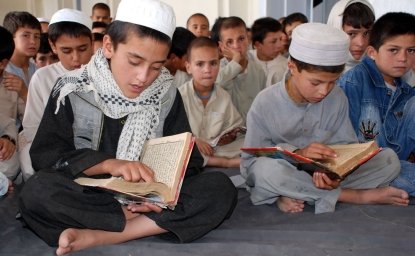
A blog of the Indo-Pacific Program
On Monday, South Korean President Yoon Suk Yeol arrived in Washington, D.C. to meet with U.S. President Joe Biden. The U.S.-ROK Presidential Summit is scheduled for Wednesday, April 26. As the summit approaches, both Washington and Seoul are in a flurry of activity. Many analysts are watching closely to see what will be at the top of the presidential agenda.
From international to domestic politics, the run-up to the summit has been diplomatically bleak. The Yoon administration recently suffered a plague of rough policy decisions—starting with Yoon’s attempts to defrost South Korea’s relations with Japan which was poorly received at home—and a series of political scandals breaking in the news.
Incidents, from the sudden resignation of his national security advisor just weeks ahead of the U.S.-ROK Summit to the recent reports of leaked documents pointing to U.S. spying on South Korean leadership, have marred the political atmosphere ahead of Biden and Yoon’s meeting.
The situation has not gone unnoticed by the South Korean people. Yoon’s domestic approval ratings are dismally low, with only 33.6% of surveyed population supporting his current policies.
Fortunately, Yoon’s visit, his second meeting with Biden in less than a year, comes in the middle of a historical landmark for the U.S.-ROK alliance—this year celebrates the alliance’s 70th anniversary. While Biden’s administration may see the summit as an opportunity to reaffirm South Korea’s commitments to addressing China, Yoon’s team is banking greatly on clear and effective presidential summitry to revive domestic support and reaffirm U.S. security commitments vis-à-vis North Korea. For both administrations, diplomatic success at Wednesday’s summit is of highest priority.
Nuclear energy is a key area of potential where Biden and Yoon could build upon past initiatives to foster forward-looking U.S.-South Korean research and industry partnerships. During the upcoming summit, both presidents will have the opportunity to reaffirm the U.S.-ROK military alliance and economic partnership, projecting a clear path forward for cooperative commitments.
In 2022, the two leaders committed to “greater nuclear energy collaboration” especially in the areas of “global civil-nuclear cooperation” in export promotion, nonproliferation safeguards, and nuclear supply chain management. Building upon their commitments, this year, as Biden and Yoon prepare to meet in Washington, nuclear energy cooperation should be at the forefront of their cooperative agenda.
Strong History of Shared Nuclear Cooperation
A shared history of not only military but also nontraditional security, the United States has worked closely with South Korea, broadening the relationship to include key cooperation in science, technology, and industry. This October will mark the U.S.-ROK alliance’s seventieth year of military cooperation, with the two countries’ peaceful nuclear energy cooperation spanning nearly the same decades.
For nearly 70 years, the United States and South Korea have shared cooperative agreements for the exploration and expansion of peaceful nuclear energy on the Korean Peninsula and beyond.
In the aftermath of the Korean War (1950-1953), both North and South Korea lay devastated by three years of a prolonged and costly war. Rebuilding the country from the ruin, South Korea’s economy took off in the late 1960s and 70s, out pacing its neighbor to the North in reconstruction, expansion, and development of its domestic infrastructure and industry.
With an eye toward the future, U.S.-ROK civil nuclear cooperation began in the 1950s, when the two countries signed an agreement on the “Cooperation Concerning Civil Uses of Atomic Energy” in 1956. Later, South Korea joined the International Atomic Energy Agency (IAEA) in 1957, and the country’s nuclear energy interests took tangible shape in the form of South Korea’s first research reactor in 1962. Under the guidance of U.S. policy and industry leaders, South Korea initiated its first nuclear power plant project, bringing reactor unit Kori-1 online for commercial operation in 1978.
During the 1970s, South Korea continued to face a precarious situation with North Korea, prompting U.S. concern regarding potential proliferation risks on the Korean Peninsula, which was only heightened by the dual-use nature of nuclear energy infrastructure. The U.S. government agreed to continue support the South’s advancement towards peaceful nuclear energy under the precursor that South Korea recommit to a “123 Agreement” under the 1954 U.S. Atomic Energy Act and join the Nuclear Nonproliferation Treaty (NPT), both of which South Korea did in 1974 (through an amended U.S.-ROK cooperation agreement later renewed in 2015) and 1975 respectively. Through these agreements, South Korea’s commitments to peaceful use of nuclear energy still hold strong today.
Fifty years later, South Korea has risen to the status of a global nuclear energy leader. A civil nuclear energy powerhouse, South Korea is home to 25 operating reactors—ranking 6th in the world—with nuclear energy generation accounting for nearly one third of South Korea’s domestic energy needs. The Korean people hold deep pride in their country’s science and technology achievements—and, rightly so, South Korean state-owned companies, such as Korea Electric Power Company (KEPCO) and Korea Hydro & Nuclear Power (KHNP), are at the forefront of the industry.
After nearly 70 years of nuclear energy cooperation, the United States and South Korea should continue to capitalize on their shared history in science and technology advancement, working together to ensure the safe, secure, and proliferation-resistant expansion nuclear energy around the world.
The Global Future of Nuclear Energy
The window for the United States and South Korea to push forward cooperation is now. Russia’s unlawful incursion into Ukraine has left a potential vacuum in the global market for nuclear energy reactor exports—A gap which the United States and allies, if they act quickly, may raise to fill. If not, this opportunity may be left to China.
Over the next 15-20 years, global growth in nuclear energy is expected to be largely in the Indo-Pacific as both China and India work to rapidly expand their nuclear fleets, including 18 reactors under construction and 28 planned in China alone. Aiming for a national target of 120-150 GWe in nuclear capacity by 2030, China is undoubtedly the world’s fastest expanding nuclear power producer.
However, China’s nuclear energy ambitions do not end at its current 56–reactor strong domestic fleet. As part of its Belt and Road Initiative (BRI), China strives to expand its nuclear energy export through financing models offered at a highly competitive rate. China’s swift expansion in the industry has resulted in a robust nuclear export industry, amounting to a total of 15 reactor units and research facilities exported abroad to date.
In contrast, while the United States continues to boast the largest nuclear fleet globally—93 reactors accounting for 30% of the world’s total nuclear electricity generation—these reactors are heavily aged with 13 reactor closures since 2013. Only one new U.S. reactor is under construction at Vogtle Electric Generating Plant in Waynesboro, Georgia. Under the current global context, the Biden administration has devoted renewed nuclear energy investments to seriously address low-carbon energy source development at home and abroad. Through Biden’s Bipartisan Infrastructure Law, $6 billion USD has been set aside for the Civil Nuclear Credit (CNC) program to support existing nuclear energy facilities across the country. But as China’s competitive role in the global nuclear energy market increases, the United States will need to re-engage beyond the domestic infrastructure.
South Korea’s ‘nuclear team’ is well posed to advance its international exports agenda, especially in key regions, including the Middle East, Southeast Asia, and Europe.
Similarly, South Korea has also re-focused on the potential for an advanced foothold in the global civil nuclear market. While Yoon’s predecessor proposed a nuclear industry reduction plan, current-President Yoon has included it in his “GPS” (Global Pivotal State) trajectory for South Korea’s foreign policy initiatives, re-instating the nuclear energy as key to South Korea’s domestic energy mix and announcing plans to increasing South Korea’s nuclear reactor exports abroad.
South Korea’s ‘nuclear team’ is well posed to advance its international exports agenda, especially in key regions, including the Middle East, Southeast Asia, and Europe. Next year, South Korean companies will conclude a $20 billion USD contract with the United Arab Emirates, bringing online the fourth APR-1400 unit, a reactor of indigenous South Korean designed. Last August, the country won out a $2.4 billion USD deal to supply reactor components to El Dabaa, Egypt.
As more countries consider civil nuclear programs as a means to meet their raising domestic energy demands, analysts project that the nuclear landscape will expand into the Middle East, Southeast Asia, and even areas of Eastern Europe. With the prospects of advanced reactor technology and SMRs (small modular reactors), countries are finding the nuclear energy option more affordable. SMRs, which are currently under development, can be built in less time and at a mere fraction of the price and size of large-scale traditional reactors, making them a very enticing investment for nuclear curious countries. Recognizing the direction of the industry, South Korea—a forerunner in SMR technology—will be an excellent partner for U.S. industry leaders.
Summitry for Success
During the 2023 Summit, Biden and Yoon will have an opportunity to enhance U.S.-ROK shared commitment across several sectors, but civil nuclear cooperation should be high on their list, signaling close political and industry-level partnerships. Building upon their 2022 statements of commitment, Biden and Yoon’s policy teams should put forth options to encourage industry and university-level joint-research ventures and investment pathways for U.S.-ROK nuclear energy collaboration.
The United States should build upon these openings, seeking cooperation over competition.
Clear areas of cooperation could include joint projects in advanced nuclear technologies, SMRs, nuclear safety and security, extension of reactor lifespan, and nuclear waste storage. South Korean companies are already investing in the U.S. nuclear industry. A key example being SK Group’s $250 USD investment last year in TerraPower, a U.S. nuclear innovation company working toward next generation nuclear technology for advanced reactors. The United States should build upon these openings, seeking cooperation over competition.
As Russia and China’s nuclear industry’s capabilities continue to expand, the United States and allies have a closing window of opportunity. The United States and South Korea should act now to engage newcomer countries, ensuring high-standard nuclear governance and building long-term economic relations within developing regions, lest they cede global nuclear leadership to authoritarian competitors.
As the global “nuclear resurgence” widens, the U.S. government, alongside U.S. industry leaders, will want to maintain a position of leadership at the civil nuclear table. And, Yoon during Wednesday’s summit, will seek a firm show of continuity in U.S.-ROK relations. Why not address both at the same time by building on nearly seven decades of civil nuclear cooperation?
The future of nuclear energy is here—The two countries only need to raise and seize the moment.
Follow Kayla Orta, Program Associate for the Hyundai Motor-Korea Foundation Center for Korean History and Public Policy, on Twitter @KaylaOrta1. Follow the @Korea_Center on Twitter and Instagram.
The views expressed are the author's alone, and do not represent the views of the U.S. Government or the Wilson Center. Copyright 2020, Asia Program. All rights reserved.
Author


Hyundai Motor-Korea Foundation Center for Korean History and Public Policy
The Center for Korean History and Public Policy was established in 2015 with the generous support of the Hyundai Motor Company and the Korea Foundation to provide a coherent, long-term platform for improving historical understanding of Korea and informing the public policy debate on the Korean peninsula in the United States and beyond. Read more


Indo-Pacific Program
The Indo-Pacific Program promotes policy debate and intellectual discussions on US interests in the Asia-Pacific as well as political, economic, security, and social issues relating to the world’s most populous and economically dynamic region. Read more





